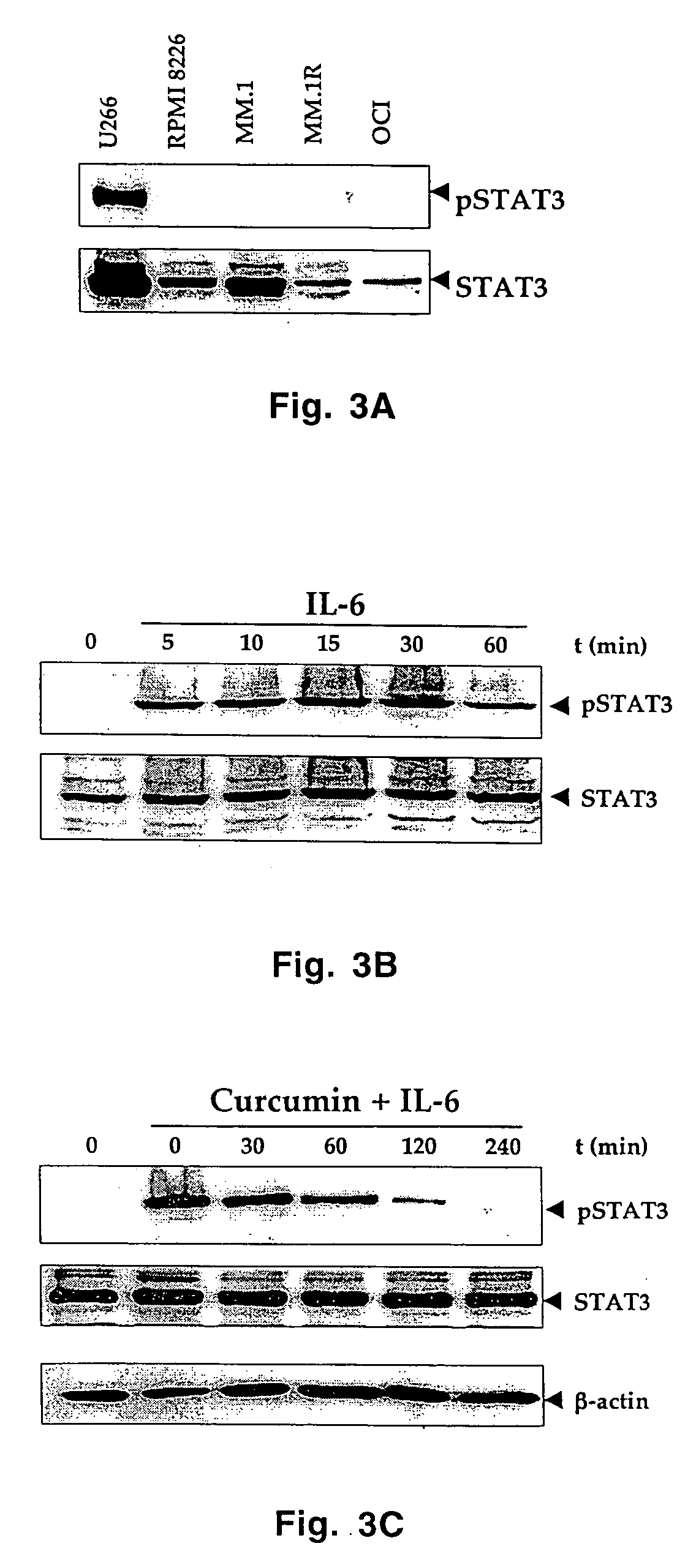Selective inhibitors of stat-3 activation and uses thereof
a stat3 activation and selective inhibitor technology, applied in the field of molecular biology of stat3, can solve the problems of pharmacologically safe and effective agents in the early stages, and achieve the effects of suppressing stat3 phosphorylation, suppressing proliferation, and promoting survival and proliferation of multiple myeloma cells
- Summary
- Abstract
- Description
- Claims
- Application Information
AI Technical Summary
Benefits of technology
Problems solved by technology
Method used
Image
Examples
example 1
[0036] Materials
[0037] Human MM cell lines U266, RPMI 8226, and MM.1S were obtained from the American Type Culture Collection (Rockville, Md.). Cell lines U266 (ATCC#TIB-196) and RPMI 8226 (ATCC#CCL-155) are plasmacytomas of B cell origin. U266 is known to produce monoclonal antibodies and IL-6 (5, 25). RPMI 8226 produces only immunoglobulin light chains, and there is no evidence for heavy chain or IL-6 production. The MM.1 (also called MM.1S) cell line, established from the peripheral blood cells of a patient with IgA myeloma, secretes lambda light chain, is negative for the presence of EBV genome, and expresses leukocyte antigen DR, PCA-1, T9, and T10 antigens (26). MM.1R is a dexamethasone (dex)-resistant variant of MM.1 cells, also known as MM.1S (27), and was provided by Dr. Steven T. Rosen of Northwestern University Medical School (Chicago, Ill.). Human MM cell line OCl was provided by Dr. James Berenson from Cedar-Sinai Hospital (Los Angeles, Calif.).
[0038] The rabbit polyc...
example 2
[0039] Cell Culture
[0040] All the human multiple myeloma cell lines were cultured in RPMI 1640 medium containing 1× antibiotic-antimycotic. U266, MM.1S, RPMI 8226 and MM.1R were cultured in 10% FBS, whereas cell line OCl was grown in Iscove's modified-Eagle's medium with 15% FBS. Cells were free of mycoplasma contamination as tested by Hoechst staining and by RT-PCR.
example 3
[0041] Western Blot
[0042] For detection of STAT proteins, whole-cell extracts were prepared by lysing the curcumin-treated cells in lysis buffer (20 mM Tris, pH 7.4, 250 mM NaCl, 2 mM EDTA, pH 8.0, 0.1% Triton-X100, 0.01 mg / ml aprotinin, 0.005 mg / ml leupeptin, 0.4 mM PMSF, and 4 mM NaVO4). Lysates were then spun at 14000 rpm for 10 min to remove insoluble material, and resolved on a 7.5% gel. After electrophoresis, the proteins were electrotransferred to a nitrocellulose membrane, blocked with 5% nonfat milk, and probed with anti-STAT antibodies (1:1000) overnight at 4° C. The blot was washed, exposed to HRP-conjugated secondary antibodies for 1 h, and finally examined by chemiluminescence (ECL, Amersham Pharmacia Biotech. Arlington Heights, Ill.).
PUM
| Property | Measurement | Unit |
|---|---|---|
| pH | aaaaa | aaaaa |
| pH | aaaaa | aaaaa |
| pH | aaaaa | aaaaa |
Abstract
Description
Claims
Application Information
 Login to View More
Login to View More - R&D
- Intellectual Property
- Life Sciences
- Materials
- Tech Scout
- Unparalleled Data Quality
- Higher Quality Content
- 60% Fewer Hallucinations
Browse by: Latest US Patents, China's latest patents, Technical Efficacy Thesaurus, Application Domain, Technology Topic, Popular Technical Reports.
© 2025 PatSnap. All rights reserved.Legal|Privacy policy|Modern Slavery Act Transparency Statement|Sitemap|About US| Contact US: help@patsnap.com



